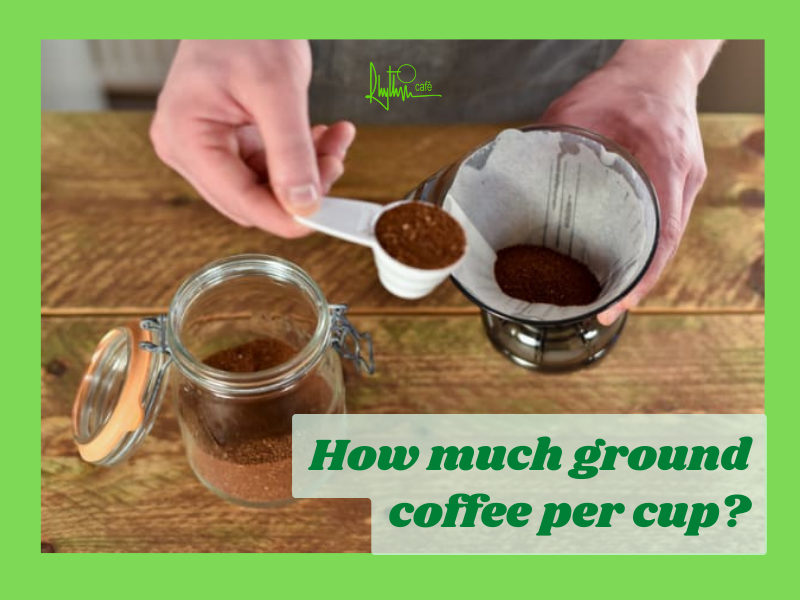Are you wondering how much ground coffee per cup to add for the perfect cup of joe? If so, you’re in the right place. Making a great cup of caffeine is an art and an exact science combined – depending on your preferences. With endless choices and personal preferences, finding that perfect balance can be daunting, but don’t worry: we’ve got all the details needed to make sure your cup of freshly brewed coffee comes out just right every time! Keep reading as we break down how much ground coffee per cup you should use, tips for optimizing your grind size and dosage levels, alternatives if measuring or weighing isn’t an option, and FAQs about dosing with ground beans. Finally get ready to enjoy a perfectly balanced brew without ever having second-guessed yourself again!
What is meant by coffee grounds?
Coffee grounds refer to the finely ground up coffee beans that are used for brewing. They are usually packaged in a container or bag and can be used for both hot and cold beverages. Coffee grounds should be kept in a cool, dry place until ready to use.
Ground coffee comes in a variety of roasts, grinds and types. The most common types are light roast, medium roast and dark roast. There is also a wide range of specialty coffees such as espresso, decaf and flavored coffees. Additionally, there are different grind sizes such as coarse, fine and extra-fine which will affect flavor and brewing time.
Factors affecting the amount of ground coffee per cup
The amount of coffee needed for each cup can vary depending on several factors, such as the type of coffee, brewing method, and cup size. Here are some of the factors that can affect the amount of coffee needed:
- Type of coffee: Different types of coffee have different flavors and strengths, which can affect the amount of coffee needed. For example, dark roast coffee has a stronger flavor and may require less coffee per cup than a lighter roast coffee.
- Brewing method: Different brewing methods, such as drip coffee, French press, or espresso, can require different amounts of coffee. For example, a French press typically requires more coffee per cup than drip coffee, as it is brewed using a coarser grind and longer steeping time.
- Cup size: The size of the cup being used can also affect the amount of coffee needed. A larger cup will require more coffee than a smaller cup to achieve the desired strength and flavor.
- Personal preference: Personal taste and preference can also play a role in determining the amount of coffee needed. Some people may prefer a stronger coffee flavor and therefore use more coffee per cup, while others may prefer a milder taste and use less coffee.
Overall, it is important to consider these factors when determining the amount of coffee needed for each cup to achieve the desired taste and strength. Experimenting with different amounts of coffee and brewing methods can help you find the perfect balance for your taste preferences.
How big is a cup of coffee?
A “cup” of coffee is traditionally 8 ounces (236 milliliters). However, the size of a cup can vary depending on the type of brewer being used and personal preference.
For example, espresso shots are typically served in 1-ounce cups (30 milliliters) while French press or pour-over coffee may be served in larger 6 or 12-ounce cups (177 to 355 milliliters).
Unlock the secret: How much ground coffee per cup?
Now that we’ve discussed the factors that can affect the amount of coffee needed, let’s get down to the nitty-gritty – how much ground coffee per cup do you need?
The standard amount of ground coffee per cup is around 1-2 tablespoons of ground coffee per 6 ounces of water (177 milliliters) – 1 tablespoon (7gram) for a milder brew and 2 tablespoons (14gram) for a stronger one. However, adjusting this amount up or down depending on your preferences and brewing method can help you achieve the perfect cup of coffee.
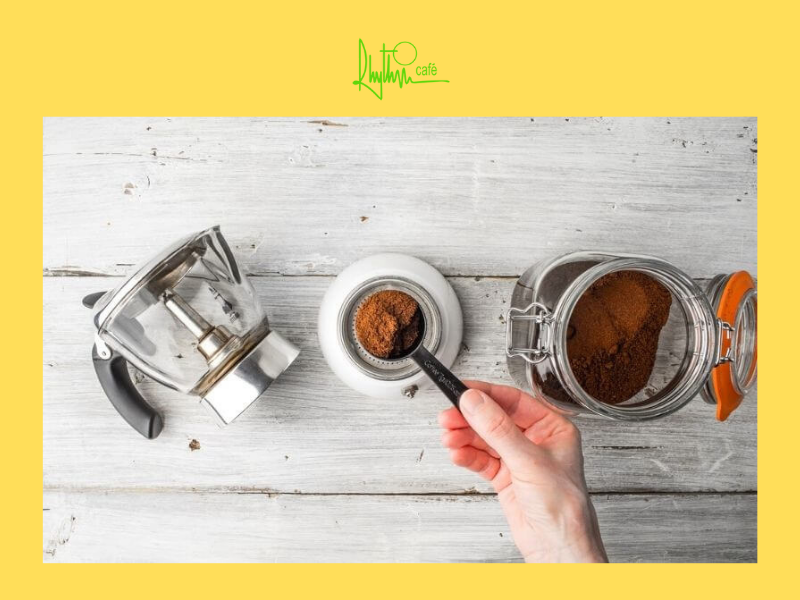
For example, if you are using a French press or pour-over method, you may want to use slightly more than 2 tablespoons for a stronger flavor, while if you are making espresso, you may want to use a bit less to avoid over-extraction.
Experimenting with different amounts of coffee can help you find the perfect balance for your taste preferences. Start by using 2 tablespoons (10 grams) of ground coffee per cup and adjust from there until you find your ideal brew.
Ground coffee quantity table
To make it easier for you to quantify ground coffee, we’ve created a Coffee quantity table. It is a helpful tool for determining the amount of coffee needed to make a great-tasting cup of coffee. These tables provide guidelines for the amount of coffee needed per cup based on various factors, such as the brewing method, cup size, and type of coffee.
You will be able to answer questions about: How much ground coffee per cup French Press? How many grams of coffee per cup Drip? How much ground coffee per cup for Espresso? How much ground coffee per cup for Pour-over? How much ground coffee per cup for Cold Brew?
| Brewing Method | Cup Size | Coffee Amount | Coffee Type | Coffee Weight |
|---|---|---|---|---|
| Drip Coffee | 6 oz | 1 tbsp | Medium Roast | 7 g |
| Drip Coffee | 8 oz | 1.5 tbsp | Medium Roast | 11 g |
| Drip Coffee | 10 oz | 2 tbsp | Medium Roast | 14 g |
| Drip Coffee | 12 oz | 2.5 tbsp | Medium Roast | 18 g |
| French Press | 8 oz | 2 tbsp | Dark Roast | 14 g |
| French Press | 12 oz | 3 tbsp | Dark Roast | 21 g |
| Pour-over | 10 oz | 2 tbsp | Light Roast | 14 g |
| Pour-over | 16 oz | 4 tbsp | Light Roast | 28 g |
| Espresso | 2 oz | 2 tbsp | Espresso Roast | 14 g |
| Espresso | 4 oz | 4 tbsp | Espresso Roast | 28 g |
| Cold Brew | 8 oz | 4 tbsp | Medium Roast | 28 g |
| Cold Brew | 16 oz | 8 tbsp | Medium Roast | 56 g |
Note:
- 1 tbsp = 1 tablespoon is equivalent to approximately 15 ml or 0.5 oz.
- This is just an example and the recommended amount of coffee may vary based on personal taste preferences and the specific type of coffee being used.
To use the coffee quantity tables, start by selecting the brewing method you will be using, such as drip coffee or French press. Then, determine the size of the cup you will be using, such as a 6-ounce cup or a 12-ounce mug. Next, consider the type of coffee you will be using, such as a dark roast or a light roast.
>> See more:
- How to make Drip coffee
- How to make Caramel iced coffee
- How to make Espresso in a French Press
- How to make Percolator coffee
- How to make Turkish coffee
Ground coffee quantity based on coffee strength
- Strong Coffee: 4 tablespoons (28 grams) of ground coffee per 6 ounces of water
- Medium Coffee: 3 tablespoons (21 grams) of ground coffee per 6 ounces of water
- Weak Coffee: 2 tablespoons (14 grams) of ground coffee per 6 ounces
How much coffee for 500 ml?
If you are using a 500-milliliter (17-ounce) container, then you will need about 10 tablespoons (70 grams) of ground coffee for a strong cup and 8 tablespoons (56 grams) for a medium cup.
For a weaker brew, use 6 tablespoons (42 grams). You can adjust these amounts as needed depending on your personal taste preferences.
Remember, experimentation is key when it comes to making the perfect cup of coffee – so don’t be afraid to try different amounts of ground coffee until you find the perfect balance for your taste preferences.
When you make more than 1 cup of coffee
When making more than 1 cup of coffee, you will need to increase the amount of ground coffee accordingly. For example, if you are making 2 cups of coffee using 6 ounces (177 milliliters) of water per cup, then you will need 4 tablespoons (28 grams) of ground coffee for a strong brew and 3 tablespoons (21 grams) for a medium one.
The amount of ground coffee needed will also depend on the size and type of container used – so make sure to adjust accordingly when making multiple cups at once.
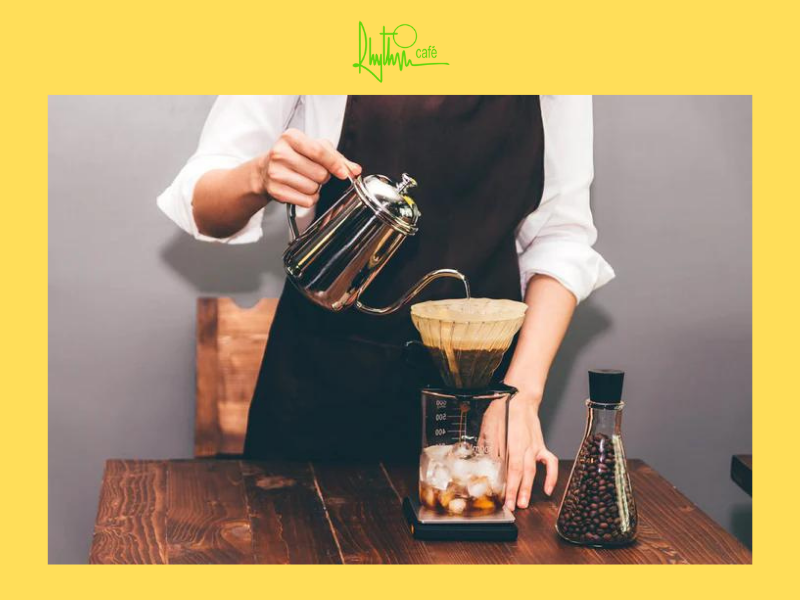
How much ground coffee do you use for 2 cups of water?
If you are making 2 cups of coffee (16 ounces or 473 milliliters), then you will need about:
- 4 tablespoons (28 grams) of ground coffee for a strong cup.
- 3 tablespoons (21 grams) for a medium cup.
- 2 tablespoons (14 grams) for a weaker brew cup.
How much ground coffee to use for 4 cups?
If you are making 4 cups of coffee (32 ounces or 946 milliliters), then you will need about:
- 8 tablespoons (56 grams) of ground coffee for a strong cup.
- 6 tablespoons (42 grams) for a medium cup.
- 4 tablespoons (28 grams) for a weaker brew cup.
How much coffee for 6 cups of water?
If you are making 6 cups of coffee (48 ounces or 1,419 milliliters), then you will need about:
- 12 tablespoons (84 grams) of ground coffee for a strong cup.
- 9 tablespoons (63 grams) for a medium cup.
- 6 tablespoons (42 grams) for a weaker brew cup.
How much ground coffee for 8 cups?
If you are making 8 cups of coffee (64 ounces or 1,892 milliliters), then you will need about:
- 16 tablespoons (112 grams) of ground coffee for a strong cup.
- 12 tablespoons (84 grams) for a medium cup.
- 8 tablespoons (56 grams) for a weaker brew cup.
How much ground coffee for 12 cups?
If you are making 12 cups of coffee (96 ounces or 2,838 milliliters), then you will need about:
- 24 tablespoons (168 grams) of ground coffee for a strong cup.
- 18 tablespoons (126 grams) for a medium cup.
- 12 tablespoons (84 grams) for a weaker brew cup.
The importance of choosing the right amount of coffee for each cup
Why do you need to measure your ground coffee? Because choosing the right amount of coffee for each cup is important for several reasons.
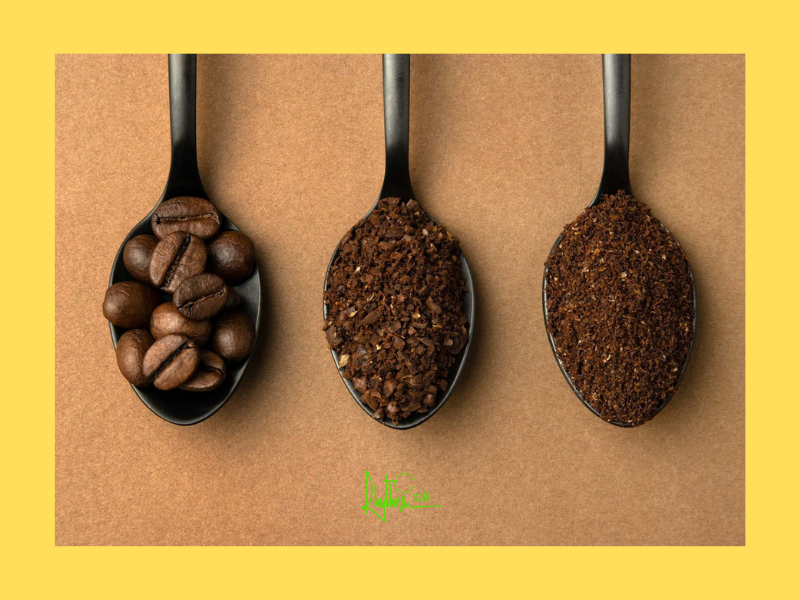
First, it affects the taste of the coffee. Using too much or too little coffee can result in a bitter or weak taste that is not enjoyable.
Second, using the right amount of coffee ensures that you get the desired caffeine content. If you use too little coffee, you may not get the energy boost you need, and if you use too much, you may experience jitters or other negative side effects.
Third, using the right amount of coffee can save you money in the long run. If you consistently use too much coffee, you will go through your coffee supply faster, which means you will need to buy more coffee more often.
Finally, different coffee brands and types have different characteristics. These variables can affect the outcome of your brew, so it’s important you measure out the necessary dose to get the best possible flavor. But don’t worry – we’ll walk you through step-by-step on how to do this like a pro!
The impact of the amount of coffee on the taste of coffee
The amount of coffee used has a significant impact on the taste of coffee. Using too little coffee can result in weak and watery coffee with a less pronounced flavor. On the other hand, using too much coffee can lead to a bitter taste that can be overpowering and unpleasant.
The right amount of coffee to use varies depending on personal preference, but a general rule of thumb is to use around 1 to 2 tablespoons of coffee grounds per 6 ounces of water. This ratio can be adjusted depending on the brewing method, type of coffee, and cup size.
Another factor that affects the taste of coffee is the coffee-to-water ratio. Using too much water can dilute the coffee and weaken the flavor, while using too little water can result in a stronger taste that can be overwhelming. It is recommended to use around 15 to 18 grams of coffee per 250 ml of water for a balanced taste.
In summary, the amount of coffee used plays a crucial role in the taste of coffee. Using the right amount of coffee and water will result in a well-balanced, flavorful cup of coffee that is enjoyable to drink.
How do you calculate coffee ratio?
The coffee-to-water ratio is used to determine the correct amount of coffee and water needed for a cup of coffee. To calculate the ratio, multiply the number of cups (in ounces) by the desired strength of coffee. For example, if you want to make two 8 ounce cups with a medium strength, you would multiply 2 (cups) x 8 (ounces) and then divide the result by 18 (the strength ratio). This would give you a total of 1.11 ounces or 16.7 grams of coffee needed for two cups.
If desired, you can adjust the strength of the coffee to suit your preferences by increasing or decreasing the ratio. For example, if you want a strong cup of coffee, you can use a ratio of 1:15 (1 part coffee to 15 parts water). If you prefer a milder brew, you can use a ratio of 1:20.
#Golden Ratio For Coffee To Water
The golden ratio for coffee to water is 1:18. This means that for every 18 ounces (510 ml) of water, you add 1 ounce (28 grams) of ground coffee. This ratio can be adjusted depending on personal preference and the type of brewing method used.
It is important to note that this ratio can be adjusted depending on the type of coffee and brewing method used. For example, for a French press or an espresso machine, you may want to use a higher ratio of coffee (e.g., 1:15) in order to get a stronger flavor.
Overall, the golden ratio provides a good starting point for making great tasting coffee, however, it is important to experiment with different ratios and brewing methods in order to find the one that best suits your taste.
#Stronger Coffee Ratio
If you prefer a stronger-tasting cup of coffee, you may want to increase the amount of ground coffee used. Generally, for every 8 ounces (237 ml) of water, about 3–4 tablespoons (21–28 grams) of coffee can be used for a strong brew. Additionally, using espresso or dark roast coffee beans can also help to achieve a stronger flavor.
#Less Coffee/More Water Ratio
For those who prefer weaker coffee, the amount of ground coffee used can be reduced. For every 8 ounces (237 ml) of water, around 1–2 tablespoons (7–14 grams) of coffee should provide a milder flavor. Additionally, using lighter roast beans or cold brew coffee can also help to achieve a more subtle flavor.
How do you measure coffee grounds?
The first step is to calculate how much coffee you need for each cup. This can be done through the Coffee-to-Water Ratio, which is one of the most important aspects of making a great cup of joe. In general, it is recommended that you use 2 tablespoons (10g) of ground coffee for every 8oz (240ml) of water. This can be adjusted depending on the type of coffee being used and personal preference, but it’s a great place to start.
Once you have determined the ratio for your desired cup size, you’ll need to measure out the necessary amount of ground coffee. To do this accurately, you can use the following ways:
1-Use a scale
The most accurate way to dose with ground coffee is to use a kitchen scale. By measuring out the exact amount of beans you need, you will ensure consistent flavor in every cup. Additionally, this method allows for precise measurements needed when experimenting with different bean types or blends.
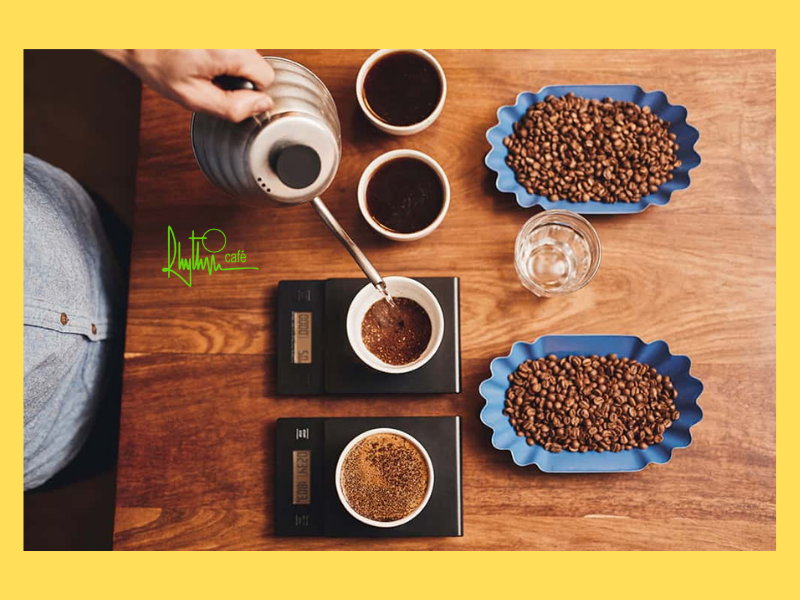
Alternative ways to measure for those without a scale:
2-Use a measuring spoon
If you don’t have a scale, measuring spoons are a convenient way to measure out the exact amount of ground coffee for each cup. Most tablespoons and teaspoons hold between 5-7 grams of ground beans, so you may need to use more than one spoon if using larger doses.
In general, most tablespoons and teaspoons of coffee equals approximately 10.6 grams. So, for a cup of coffee, you will want to use 1 ½ to 2 tablespoons of coffee grinds. This does not apply to instant coffee crystals. If you prefer to use scoops, make sure each scoop is equivalent to 2 tablespoons.
3-Use disposable paper coffee filters
Some coffee makers come with disposable paper filters that are measured out for a single cup of coffee. These can be placed directly into the brewer, and then filled with ground beans. All you need to do is fill it up to the indicated line and you have the perfect dose! This can save you time and energy when trying to make multiple cups at once, as each filter will contain the right amount of grounds for one cup.
4-Use prepared scoops
Many coffee packages come with pre-measured scoops that can be used as a guide for how much ground beans should be used per cup. For example, some brands may offer 1 scoop per 6oz cup and 2 scoops per 12oz cup.
5-Using fingertips
You can also use your fingertips to measure the amount of ground coffee needed for each cup. With a bit of practice, you will be able to estimate how much is needed using this method. Start by filling one teaspoon of ground coffee, then add or take away until it looks like the same amount as your desired dose.
6-Use your eye
If neither of these methods is available, you can also use your eye to estimate the amount of ground coffee you need. This can be tricky, but it is possible with a bit of practice and experience. Start by filling your measuring spoon just over halfway, then add more or less until it looks like the same amount as your desired dose.
Once you have measured out your dose, it’s time to brew! Follow the brewing instructions of your coffee maker and enjoy a perfectly balanced cup of joe that you made with your own hands.
How to brew the perfect cup of coffee?
Once you have measured out your dose of ground coffee, it’s time to brew! Different types of coffee makers may require different instructions for the brewing process, so make sure to read through the manual that came with your machine before getting started.
In general, most coffee makers will require a few basic steps:
- Step 1: Fill the reservoir with cold water according to your desired cup size.
- Step 2: Place a filter inside the basket, then fill it with the measured amount of ground beans.
- Step 3: Put the basket into place and start the brewing process.
- Step 4: Once finished, pour yourself a cup and enjoy!
It’s also important to note that some coffee makers may require additional steps such as pre-heating or adding specific amounts of cream/sugar to your drink. Be sure to check for any special instructions before brewing your perfect cup.
With these tips in mind, you’re now ready to make the perfect cup of coffee every time! From measuring out the right dose of grounds to following proper brewing instructions, you’re sure to enjoy a cup that is tailored specifically to your tastes. So go ahead and give it a try – you won’t regret it!
How much caffeine coffee per cup?
The amount of caffeine [1] in each cup of coffee can vary greatly depending on the type of bean, the brewing method, and other factors. Generally, a 6-ounce cup of regular brewed coffee contains between 60-120 milligrams of caffeine. However, specialty drinks such as espresso and cappuccino may contain significantly more since they are made with a concentrated coffee base. It’s important to consider your individual tolerance when drinking any caffeinated beverage. If you’re sensitive to caffeine or have other health concerns, it’s best to consult your doctor before consuming large amounts.
When deciding how much coffee to make for yourself or for guests, keep these tips in mind:
- For lighter doses and less caffeine per cup, use less ground beans per cup.
- For richer, bolder flavors and more caffeine per cup, use more ground beans per cup.
- If using a traditional drip coffee maker, adjust the amount of water according to your desired strength.
- If using an espresso machine or French press, opt for a finer grind size to produce stronger beverages.
By keeping these tips in mind, you can make sure that each cup contains the right amount of caffeine for your individual tastes and preferences.
>> See more: How much caffeine is in a Starbucks Frappuccino
How to store coffee grounds?
Coffee grounds should be stored in an air-tight container away from heat and moisture. As coffee grounds are porous, they can easily absorb odors and flavors from other food items. It’s best to store them in a cool, dry place such as a pantry or cupboard. If you don’t plan on using the grounds within two weeks of opening the package, freeze them in an air-tight bag or container until ready to use. This will help ensure that their flavor and aroma remains intact for longer.
How long does ground coffee last?
Ground coffee will generally stay fresh for up to three weeks when stored in a cool, dark place. If stored in the freezer, it can remain fresh for up to six months. Be sure to store your grounds in an air-tight container or bag away from heat and moisture.
>> See more: How long do coffee beans last?
FAQs about How much ground coffee per cup
Is coffee powder the same as coffee grounds?
Yes coffee powder and coffee grounds are the same thing. They are simply ground up coffee beans that have been processed into a powdery or granular form.
What is the best kind of coffee to use?
The type of coffee you use will depend on your personal preference. You may prefer milder blends such as Arabica or Robusta, or you may enjoy more full-bodied coffees like espresso and French press. Experiment with different types to find out what works best for you!
How much should I measure out per cup?
This will depend on how strong you like your coffee and the type of machine you’re using. For drip machines, start with two tablespoons (10 grams) per 6 ounces of water. For espresso machines, use 7-10 grams per shot.
Can I reuse coffee grounds?
No, it is not recommended to reuse coffee grounds as this could lead to bitter and unpleasant flavors. If you want to make multiple cups of coffee, it’s best to use fresh grounds each time.
How do I know when my coffee is done brewing?
Most modern coffee makers will indicate when the brewing process is complete with either a light or sound indicator. If your machine does not have an indicator, simply look for signs that the water has stopped dripping from the filter basket. Once completed, remove the carafe from the heating plate and enjoy your freshly brewed cup!
What is the ratio of coffee to water?
The ratio of coffee to water is typically 1:16, meaning 1 part ground coffee to 16 parts hot water. This ratio can be adjusted depending on your desired strength and flavor.
What is the perfect ratio of water and milk in coffee?
The perfect ratio of water and milk in coffee will depend on your personal preference. However, a good starting point is 1 part espresso to 2 parts steamed milk, or 1 part instant coffee to 2 parts hot water and 1 part warm milk. Adjust the ratios according to taste.
What is 2 to 1 coffee ratio?
The 2 to 1 coffee ratio is a popular brewing guide used by baristas. It refers to the ratio of coffee grounds to water, which should be 2 tablespoons (10 grams) of ground coffee for every 6 ounces (180 milliliters) of hot water. Adjust the ratios according to your desired flavor and strength.
What other drinks can I make using ground coffee?
Ground coffee can be used to make many delicious drinks such as cold brews, frappes, lattes, cappuccinos and more. Experiment with different combinations to find the perfect balance of flavors for you!
What is the difference between instant coffee and ground coffee?
Instant coffee is made from pre-brewed, dehydrated coffee granules which dissolve easily in water. Ground coffee is fresh roasted and freshly brewed, requiring preparation before drinking. Instant coffees typically have a weaker flavor compared to freshly brewed coffee made with ground beans.
What are coffee grounds made of?
Coffee grounds are made from freshly roasted and ground coffee beans. The beans are ground into a fine powder or granules that can be used in various brewing methods.
What is the shelf life of ground coffee?
The shelf life of ground coffee depends on how it is stored. Ground coffee will typically stay fresh for up to three weeks when stored in a cool, dark place away from heat and moisture. If stored in the freezer, it can remain fresh for up to six months. Be sure to store your grounds in an air-tight container or bag away from heat and moisture.
What is a substitute for coffee grounds?
If you are looking for a substitute for coffee grounds, consider using ground chicory root or instant espresso powder. Both of these options will provide a similar flavor to freshly brewed coffee made with ground beans. However, they should be used in smaller amounts as their flavor is more concentrated than regular ground coffee.
How does coffee grounds fertilize soil?
Coffee grounds are an excellent organic fertilizer for soil. They are rich in nitrogen, potassium and phosphorus which help plants to grow healthy and strong. Coffee grounds can be used as a top dressing or added directly to soil when planting new plants. Additionally, coffee grounds can help to attract beneficial insects such as earthworms which aerate the soil.
Do coffee grounds repel mosquitoes?
Coffee grounds have been rumored to repel mosquitoes, however this is not backed up by scientific research. It is best to take traditional steps such as using insect repellents or removing standing water near your home in order to protect yourself from mosquito bites.
Is ground coffee healthy?
Yes, ground coffee is considered to be a healthy beverage. It contains antioxidants and can help to improve mental alertness and focus. However, it is important to note that consuming too much caffeine can have adverse effects so it is best to enjoy your cup of joe in moderation!
What are the health benefits of drinking ground coffee?
Ground coffee has many potential health benefits including improved cognitive function, reduced risk of certain diseases and weight loss. It also contains beneficial compounds such as polyphenols which may protect against inflammation and other chronic conditions. In addition, drinking ground coffee on a regular basis could help reduce stress levels and improve mood.
Conclusion
Brewing the perfect cup of coffee can be a challenge. From selecting the right brand and style of beans, to calculating just how much ground coffee per cup you need for optimal flavor – there’s a lot to consider when it comes to crafting an exceptional morning beverage.
The amount of ground coffee to use when making a cup depends on your desired strength and flavor. As a general rule, we recommend using two tablespoons (10 grams) of ground coffee for every 6 ounces (180 milliliters) of hot water.
With a bit of practice and knowledge, you can be sure to create an amazing cup each time. So go ahead – experiment with different combinations of ground coffee and explore the wonderful world of coffee! Happy sipping!

Hi, I’m Zelda Kain. I love coffee – probably a little too much! I work as an admin at Rhythmcafe, a local spot renowned for its fresh ingredients and delicious coffee. I also review home appliances such as grinders, espresso machines, and more. I’ve tried out almost every model available, so if you’re in the market for any of these items be sure to check out my reviews!

